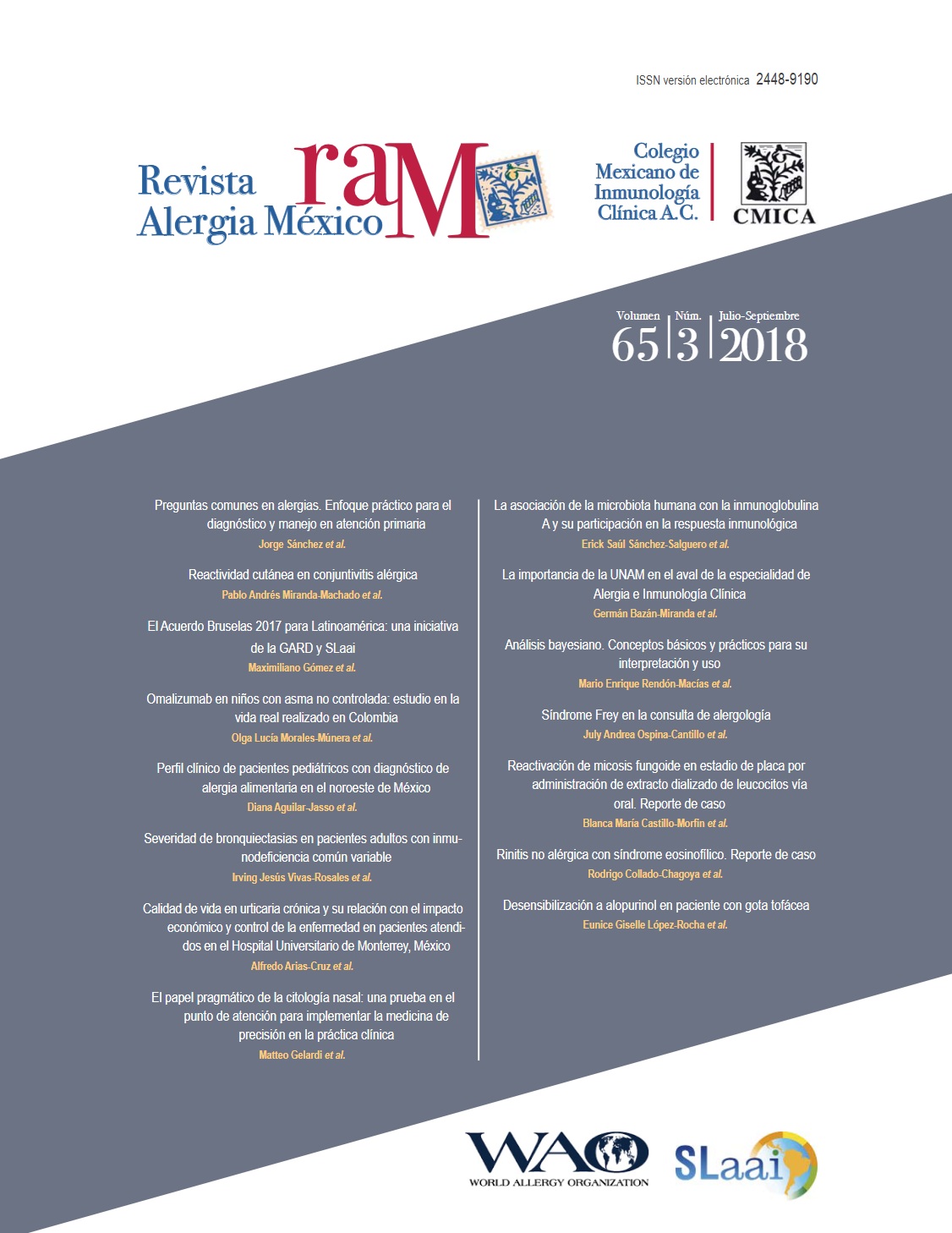Abstract
Background: Food allergy is an adverse reaction secondary to a specific immune response after exposure to a food. Knowing the natural course of food allergies is essential for opportune diagnosis and treatment.
Objective: To know the clinical profile of children diagnosed with food allergy attended to at the pediatric allergology department of a secondary care hospital.
Method: Cross-sectional study of medical records of children with a confirmed diagnosis of food allergy. The type of food allergy, initial clinical presentation, history of familial atopy, time of breastfeeding, ablactation age and positive food allergens per patient, among others, were assessed. Descriptive analysis was performed and association was searched with the chi-square test.
Results: Females were predominant among 95 patients. Milk, soy, wheat and egg were the foods with more allergic responses. Predominant clinical manifestations were gastrointestinal. The time from symptoms’ onset to definitive diagnosis was 3.2 years. Food allergy was associated with an ablactation age ≥ 6 months, milk and soy with respiratory and gastrointestinal symptoms, egg with respiratory and dermatological symptoms, and wheat with gastrointestinal symptoms.
Conclusions: Food allergies in our population appeared mainly as gastrointestinal symptoms and there was an association between clinical presentation and allergenic foods.
References
Medina-Hernández A, Huerta-Hernández R, Góngora-Meléndez M, Domínguez-Silva G, Mendoza-Hernández DA, et al. Perfil clínico-epidemiológico de pacientes con sospecha de alergia alimentaria en México. Estudio Mexipreval. Rev Alerg Mex. 2015;62:28-40.
Puente-Fernández C, Maya-Hernández R, Flores-Merino M, Romero-Figueroa MS, Barajas M, Domínguez-García MV. Self-reported prevalence and risk factors associated with food hypersensitivity in Mexican young adults. Ann Allergy Asthma Immunol. 2016;116(6):523-527. DOI: 10.1016/j.anai.2016.03.010
Alkazemi D, Albeajan M, Kubow S. Early Infant feeding practices as possible risk factors for immunoglobulin e-mediated food allergies in Kuwait. Int J Pediatr. 2018;2018:1701903. DOI: 10.1155/2018/1701903
Sharma HP, Bansil S, Uygungil B. Signs and symptoms of food allergy and food-Induced anaphylaxis. Pediatr Clin North Am. 2015;62(6):1377-1392. DOI: 10.1016/j.pcl.2015.07.008
Burks AW, Tang M, Sicherer S, Muraro A, Eigenmann PA, Ebisawa M, et al. ICON: food allergy. J Allergy Clin Immunol. 2012;129(4):906-920. DOI: 10.1016/j.jaci.2012.02.001
Bedolla-Barajas M, Bedolla-Pulido TR, Camacho-Peña AS, González-García E, Morales-Romero J. Food hypersensitivity in Mexican adults at 18 to 50 years of age: a questionnaire survey. Allergy Asthma Immunol. 2014;6(6):511-516. DOI: 10.4168/aair.2014.6.6.511
Sicherer SH, Sampson HA. Food allergy: epidemiology, pathogenesis, diagnosis, and treatment. J Allergy Clin Immunol. 2014;133(2):291-307. DOI: 10.1016/j.jaci.2013.11.020
Moussa-Afify S, Pali-Schöññ I. Adverse reactions to food: the female dominance-A secondary publication and update. World Allergy Organ J. 2017;10:43. DOI: 10.1186/s40413-017-0174-z
Elbert NJ, Kiefte-De-Jong JC, Voortman T, Nijsten TEC, De-Jong NW, Jaddoe VW, et al. Allergenic food introduction and risk of childhood atopic diseases. PLoS One. 2017;12(11):e0187999. DOI: 10.1371/journal.pone.0187999
Kattan J. The prevalence and natural history of food allergy. Curr Allergy Asthma Rep. 2017;16(7):16-47. DOI: 10.1007/s11882-016-0627-4
Rosas MR. Alergia e intolerancia alimentaria. Ámbito Farmacéutico Nutrición. 2006;25(7):56-59.
Doğruel D, Bingöl G, Altıntaş DU, Yılmaz M, Güneşer-Kendirli S. Clinical features of food allergy during the 1st year of life: the ADAPAR birth cohort study. Int Arch Allergy Immunol. 2016;169(3):171-180. DOI: 10.1159/000444639
Wood RA. The natural history of food allergy. Pediatrics. 2003;111(6 Pt 3):1631-1637.
Hoz B. Etiopatogenia. En: Hoz B, Dordal T, Enrique E. Alergias respiratorias 2020. España: Euromedice; 2012.
Bedolla-Barajas M, Alcalá-Padilla G, Morales-Romero J, Camacho-Fregoso J, Rivera-Mejía V. Peanut allergy in Mexican children: what is the effect of age at first consumption? Iran J Allergy Asthma Immunol. 2016;15(1):53-61.
Chinthrajah RS, Hernandez JD, Boyd SD, Galli SJ, Nadeau KC. Molecular and cellular mechanisms of food allergy and food tolerance. J Allergy Clin Immunol. 2016;137(4):984-997. DOI: 10.1016/j.jaci.2016.02.004
Bedolla-Barajas M, Bedolla-Pulido TR, Macriz-Romero N. Prevalence of peanut, tree nuts, sesame, and seafood allergy in Mexican adults. Rev Invest Clin. 2015;67(6):379-386.
Savage J, Sicherer S, Wood RA. The natural history of food allergy. J Allergy Clin Immunol Pract. 2003;4(2):196-203. DOI: 10.1016/j.jaip.2015.11.024
Supo J. Chi cuadrada prueba de independencia [Internet]. Peru: Bioestadístico; 2011 [Consultado 2012 Aug 16]. Disponible en: http://bioestadistico.com/chi-cuadrado-prueba-de-independencia

This work is licensed under a Creative Commons Attribution-NonCommercial 4.0 International License.
Copyright (c) 2018 Revista Alergia México

